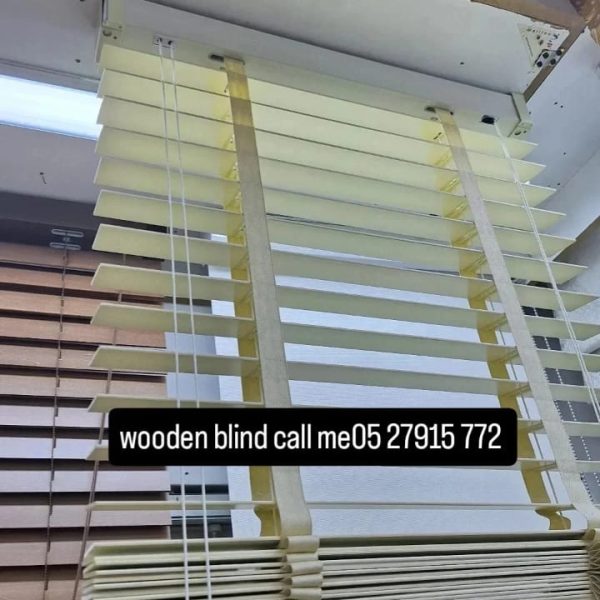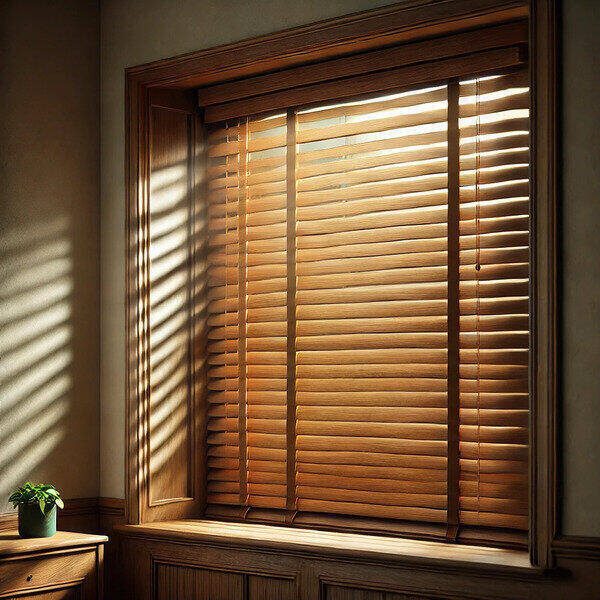Wooden blinds are a classic window treatment that brings natural warmth, texture, and sophistication to any space. Whether you prefer the rich grain of genuine hardwood or the moisture-resistant convenience of faux wood, these shades combine beauty and durability. Read on for everything you need to know—types, benefits, buying tips, installation, care, styling ideas, and more.
1. What Are Wooden Blinds?
Wooden blinds consist of horizontal slats made from either real wood or composite materials that mimic wood. The slats are suspended on durable cords or tapes and can be tilted to adjust light and privacy. When raised, the slats stack neatly at the top of the window, offering an unobstructed view.
2. Types of Wooden Blinds
2.1 Real Hardwood Blinds
- Materials: Basswood, oak, maple, bamboo
- Appearance: Rich grain patterns, warm tones, natural texture
- Ideal For: Living rooms, dining rooms, home offices—areas with moderate humidity
2.2 Faux Wood (Composite) Blinds
- Materials: PVC, vinyl, or engineered wood composites
- Appearance: Wood-like finish available in whitewash, driftwood, walnut, and more
- Ideal For: Bathrooms, kitchens, laundry rooms—areas prone to moisture and humidity
3. Key Features & Benefits
3.1 Natural Warmth & Aesthetic Appeal
Wooden blinds impart a cozy, organic feel. The grain and finish complement wood floors, furniture, and neutral palettes for a cohesive look.
3.2 Superior Light Control & Privacy
Tilt the slats from 0°–180° to let in soft filtered light or block glare entirely. Fully lower the blind for complete privacy.
3.3 Insulation & Energy Savings
Thicker wooden slats provide thermal insulation. In summer, they reduce heat gain; in winter, they help retain warmth—lowering your energy bills.
3.4 Durability & Longevity
- Hardwood Blinds: With proper care, they can last 10–15 years.
- Faux Wood Blinds: Resistant to warping, cracking, and fading—ideal for high-humidity environments.
3.5 Easy Maintenance
Dust weekly with a microfiber cloth or use a soft brush attachment on your vacuum. Faux wood slats can be wiped with a damp cloth and mild detergent.
3.6 Eco-Friendly Options
- Sustainably Sourced Wood: FSC-certified basswood and bamboo options.
- Recyclable Composites: Some faux wood materials are made from recycled plastics.
4. How to Choose the Right Wooden Blinds
4.1 Measure Accurately
- Width: Measure inside the jamb at the top, middle, and bottom; use the smallest measurement for an inside mount.
- Height: Measure from the top of the jamb to the sill or desired drop.
- Depth: Ensure at least 5 cm for inside-mount headrails.
4.2 Select Mounting Style
- Inside Mount: Sleek, frame-fit look; showcases window trim.
- Outside Mount: Makes small windows appear larger; covers imperfections.
4.3 Choose Slat Size
- 50 mm (2”) Slats: Give a delicate, traditional look.
- 63 mm (2.5”) & 70 mm (2.75”) Slats: Offer a more modern, substantial appearance.
4.4 Decide on Control Mechanism
- Corded: Classic lift-and-tilt; ensure child-safe tensioners.
- Cordless: Clean lines, safer for children and pets.
- Motorized: Remote/app control, programmable schedules, voice-activated via smart home systems.
5. # Installation Guide
At CurtainFix, we’ve installed wooden blinds across thousands of homes in Dubai over the past 15+ years. Here’s our proven process:
- Gather Tools
Drill, screwdriver, tape measure, pencil, spirit level, wall plugs (if required). CurtainFix brings all specialized tools and ensures precise measurements on-site. - Mark Bracket Positions
Use a spirit level to align brackets perfectly. Our installers position for optimal slat clearance and smooth operation. - Drill Pilot Holes & Insert Anchors
Secure brackets into studs or with heavy-duty wall anchors suitable for drywall or masonry. - Attach Headrail & Slats
Snap the headrail into place, then clip in each slat or lift bar. Our team handles real wood, faux wood, and even custom curved installations. - Test Operation
Raise, lower, and tilt slats multiple times to confirm flawless performance. We complete a detailed quality check—cord tension, bracket stability, and motor function if motorized.
6. Care & Maintenance
- Weekly Dusting: Gently wipe slats with a microfiber cloth or vacuum brush.
- Spot Cleaning: For faux wood, wipe with a damp cloth and mild soap; avoid excess water. Real wood should not be saturated—use a dry or slightly damp cloth only.
- Annual Inspection: Check cords, tapes, and hardware; tighten loose brackets or replace worn components to prolong lifespan.
7. Styling Ideas
- Layer with Curtains: Pair wooden blinds with sheer curtains to soften the look and add dimension.
- Contrast Trim: Choose a darker stain against white walls for a dramatic effect.
- Uniform Palette: Match slat color to hardwood floors for a seamless, cohesive aesthetic.
- Accent Valance: Add a decorative pelmet or cornice for a formal living room or study.
8. Frequently Asked Questions
Q: Are wooden blinds suitable for bathrooms?
A: Use faux wood blinds—they’re moisture-resistant and won’t warp or peel in humid conditions.
Q: How long do real wood blinds last?
A: With proper care, high-quality hardwood blinds can last 10–15 years or more.
Q: Can I motorize my existing wooden blinds?
A: Yes—CurtainFix offers retrofit motor units for both real and faux wood systems, complete with smart-home integration.
Conclusion
Wooden blinds are a timeless investment, blending natural beauty with practical performance. From real hardwood warmth to moisture-proof faux options, and from manual cords to advanced motorization, there’s a wood blind solution for every window, style, and budget. Trust curtainfix 15+ years of expertise to deliver flawless measurement, installation, and after-sales service—transforming your space with the perfect wooden blinds.
📞 Chat on WhatsApp: +971 52 791 5772
📧 Email: [email protected]
🌐 Website: www.curtainfix.com


